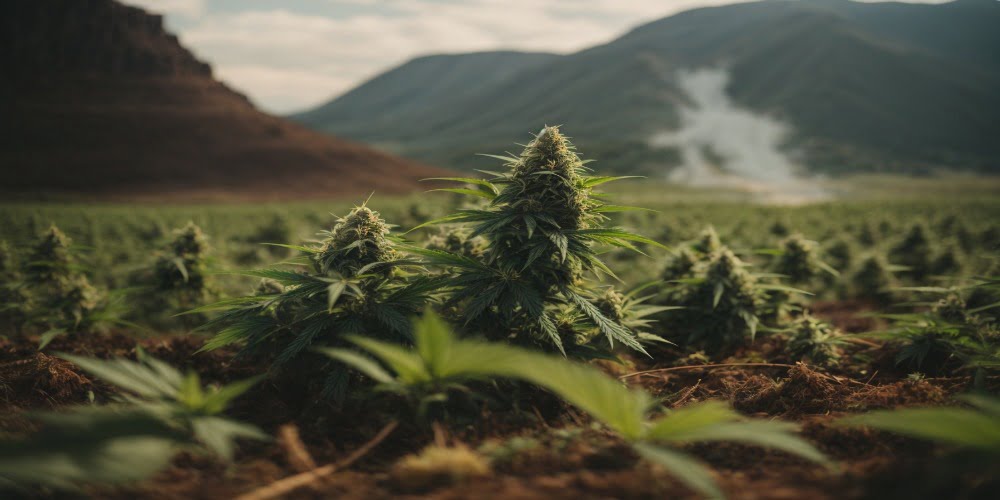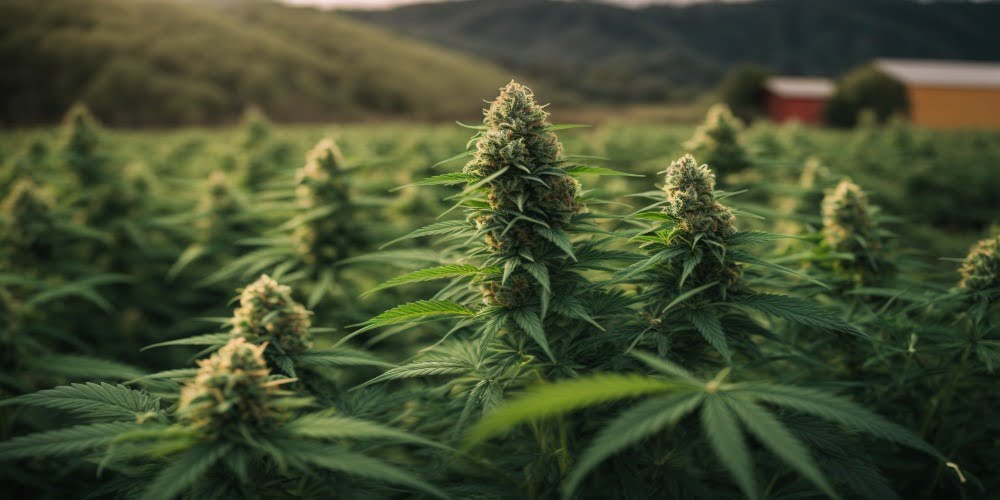A Concise History of Hemp in the United States

Hemp, a versatile plant with a rich history, has been intertwined with the United States for centuries. From colonial times to the modern era, hemp has played a vital role in American agriculture, industry, and culture. In this article, we explore the captivating journey of hemp in the United States, from its early cultivation to its recent resurgence.
- What is Ganja: Unveiling the Origins, Uses, and Culture of Cannabis
- Cannabis in pop-culture: iconic movies and songs
- California cannabis-friendly destinations
Colonial Beginnings

History of hemp in the United States traces its roots to the early 17th century when European settlers first set foot on the continent’s shores. These intrepid newcomers carried with them a precious cargo: hemp seeds. They quickly recognized the plant’s remarkable utility and set about cultivating it for its valuable fibers. These sturdy hemp fibers found myriad applications, serving as the raw material for textiles, ropes, and sails. In a historical tidbit worth noting, some of the earliest American flags, including the one famously sewn by Betsy Ross, were crafted from this versatile hemp.
History of Hemp contribution to early American life was indeed significant. It was an essential commodity that played a pivotal role in the growth and development of the colonies. As a source of textiles and essential materials for maritime pursuits, hemp was woven into the fabric of American society from its very inception, leaving an enduring mark on the nation’s history. The journey of cannabis in America had only just begun, and its influence would continue to evolve and adapt in the centuries to come.
Revolutionary Uses

In the crucible of the American Revolution, hemp emerged as a critical player in the quest for independence. George Washington, the revered founding father and a hemp farmer himself, recognized the plant’s paramount importance and actively encouraged its cultivation among his fellow colonists. This visionary decision would prove to be a game-changer.
Hemp’s multifaceted utility became manifest during these tumultuous times. The sturdy fibers of this versatile plant were harnessed for the creation of essential items for the Continental Army. Uniforms for the brave soldiers, gunpowder bags to carry the ammunition, and tents to shield them from the elements were all crafted from hemp. This remarkable plant, in many ways, was the backbone of the American military effort.
Hemp in the 19th Century

The 19th century marked a significant turning point in the American hemp industry. During this era, hemp production experienced a notable expansion, with Kentucky emerging as a formidable powerhouse in the cultivation of this versatile plant. It was during this time that Kentucky proudly earned its well-deserved moniker as the “Hemp State.”
The 19th-century surge in hemp production solidified its reputation as a versatile and valuable crop. The contributions of Kentucky, in particular, played a pivotal role in establishing hemp as an integral part of American industry. This era set the stage for the plant’s continued significance, which would endure and evolve in the years to come.
Dive into classic strains with the Blueberry — 5 original mini joints — five compact pre-rolls, each with a quarter gram of iconic Blueberry cannabis.
The CANNABIS Tax Act

The decline of hemp in the United States commenced with the enactment of the Marihuana Tax Act in 1937. This legislative move marked a significant turning point in the history of hemp as it imposed onerous taxes and stringent regulations on the cultivation and sale of all cannabis plants, which included hemp. The primary objective of the act was to curb the recreational use of marijuana, which was gaining attention and scrutiny during this period.
The heavy taxation and strict regulatory measures burdened hemp farmers and industries, rendering the cultivation of hemp less economically viable. As a result, the once-prominent hemp industry in the United States began to wither away, leading to a decline that would persist for decades. This unintended consequence of the Marihuana Tax Act played a pivotal role in shaping the trajectory of hemp’s history in the United States.
History of Hemp during World War II

Hemp played a crucial and unexpected role during World War II, further underscoring its historical significance in the United States. As the world plunged into the throes of war, the American government recognized the value of hemp and initiated the “Hemp for Victory” campaign.
The campaign, launched in 1942, encouraged American farmers to actively engage in hemp cultivation. The goal was to supply the military with the vital raw materials required for the war effort. Hemp’s durable fibers were in high demand for the production of essential items, including uniforms for the troops, rope for naval vessels, and parachute cords.
The need for such materials was pressing, and hemp emerged as a readily available solution. With the cultivation of hemp on the rise, the United States managed to secure a sustainable source of these critical supplies, aiding the war effort significantly.
The Decline of American Hemp

Despite experiencing a notable resurgence during World War II, American hemp encountered a challenging post-war period. The decline of hemp production gained momentum as alternative fibers, such as cotton and synthetic materials, began to rise in popularity. This shift in consumer preferences and industrial practices led to a sharp decline in the cultivation of hemp across the nation.
The situation for American hemp worsened with the introduction of the Controlled Substances Act of 1970. This legislation, in response to concerns about drug abuse, categorized hemp as a Schedule I controlled substance. This classification meant that hemp was treated in the same legal category as substances like heroin and LSD, leading to stringent regulations and making its cultivation even more challenging.
Meet Jealousy — Cannabis Flower, a fantastic hybrid strain. Jealousy is known for its balancing effects. The dominant terpene of this strain is caryophyllene, which is often associated with a fuel aroma.
The Hemp Renaissance

The late 20th century and early 21st century witnessed a rekindled enthusiasm for hemp, as advocates fervently championed its industrial and agricultural potential. This renewed interest marked a significant departure from the decades of stagnation that had plagued the American hemp industry.
In a pivotal moment, the United States took a notable step toward acknowledging hemp’s value in 2014. The U.S. Farm Bill opened the door for pilot programs dedicated to researching the growth of industrial hemp in specific states. This change in policy represented a major milestone, offering a glimmer of hope for the resurgence of the American hemp industry.
The shift in perspective brought about by the 2014 Farm Bill allowed states to experiment with the cultivation of hemp, paving the way for renewed research and development. This change in the regulatory landscape breathed new life into an industry that had long been constrained by outdated policies and attitudes.
The 2018 Farm Bill

The passing of the 2018 Farm Bill stands out as one of the most momentous events in modern American hemp history. This legislative milestone not only legalized the cultivation of industrial hemp across the nation but also redefined its status. Hemp was no longer shackled by its association with controlled substances; instead, it was officially recognized as a distinct agricultural commodity.
In essence, the 2018 Farm Bill opened the door for American farmers to re-embrace hemp as a valuable and sustainable crop, rekindling the nation’s historical connection with this versatile plant. This legislative transformation set the stage for the resurgence of the American hemp industry, paving the way for innovation and growth in the 21st century.
A Growing Industry

The removal of legal barriers has ushered in a resurgence of the American hemp industry. Farmers from coast to coast are enthusiastically reintroducing hemp into their crop rotations, seizing the opportunity to cultivate this versatile plant once again. Simultaneously, entrepreneurs have recognized the vast potential of hemp and are developing a wide array of hemp-based products, ranging from textiles and food to cosmetics and CBD extracts.
This renaissance of hemp has brought about more than just economic possibilities; it has also become a catalyst for rural communities growth and revitalization. The resurgence of the hemp industry has generated employment opportunities in areas where they are sorely needed, injecting fresh life and prosperity into these regions. In this way, the legalization and resurgence of hemp cultivation have not only restored a vital component of American agriculture but have also contributed to the economic and social well-being of rural communities across the nation.
Cannabis Industry in 2023

The cannabis industry in the United States is continuing to grow rapidly in 2023. Legal cannabis sales are expected to reach $37 billion this year, up from $25 billion in 2022. This growth is being driven by increasing consumer acceptance and legalization in more states.
Consumer acceptance of cannabis has grown significantly in recent years, as more people have become aware of its potential benefits for a variety of medical and recreational uses. This growing acceptance is being reflected in the growing number of states that have legalized cannabis for medical and/or recreational use. In addition to increasing consumer acceptance, the cannabis industry is also benefiting from the legalization of cannabis in more states. As more states legalize cannabis, the market for legal cannabis products expands, creating new opportunities for businesses in the industry.
The cannabis industry is still highly regulated, but there are signs that federal legalization is becoming more likely. The House of Representatives passed a bill to legalize cannabis at the federal level in April 2023, but the bill has not yet been taken up by the Senate.
The history of hemp in the United States is a tale of resilience and adaptation. From its colonial roots as a crucial crop, to its near demise due to legislation, and its resurgence as a versatile and sustainable resource, hemp has played a unique role in shaping American history. Today, as the nation re-embraces the potential of hemp, it stands on the cusp of a new era of innovation and opportunity, driven by this remarkable plant that has woven its fibers into the fabric of American culture and industry.
In this evolving narrative, APE Premium Cannabis corp. has emerged as a pivotal player, influencing the story with its commitment to quality and accessibility. As a company deeply rooted in the principles of sustainability and innovation, APE Premium Cannabis corp contributes significantly to the renaissance of hemp in the modern era. With a focus on producing top-tier cannabis products, APE demonstrates the untapped potential of hemp, transforming it into premium offerings that cater to a discerning clientele.
The company’s reach extends far beyond its quality products. With over 400 dispensaries and deliveries where consumers can access their products, APE Premium Cannabis corp is not just a part of the hemp industry’s history, it’s a driving force in its future.




























